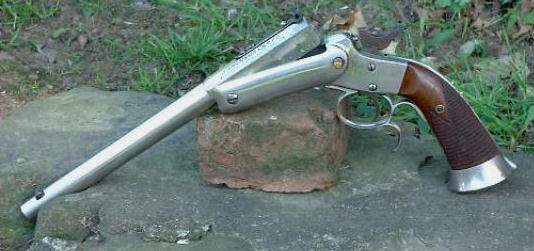

 The Accurate Reloading Forums
The Accurate Reloading Forums  THE ACCURATE RELOADING.COM FORUMS
THE ACCURATE RELOADING.COM FORUMS  Guns, Politics, Gunsmithing & Reloading
Guns, Politics, Gunsmithing & Reloading  Single Shot Pistols
Single Shot Pistols  tight neck vs. match neck ?
tight neck vs. match neck ?Go  | New  | Find  | Notify  | Tools  | Reply  |  |
| one of us |
Has anyone out there had any experience/comments on the accuracy difference between a tight-necked chambered gun vs. a match-neck, which is I believe, cutting the chamber such that the neck is only a few thousandths larger than twice the neck thickness (for a particular lot of brass)+ bullet diameter?? Is it worth the extra time to turn necks?? Generally, what kind of accuracy difference will I notice between the 2??? My thinking is that if the bullet is seated into the lands this should negate the neck turning procedure. Correct... Mike??? | ||
|
Moderator |
I have never heard of a scientific test to show what the accuracy benefits are of a "match" neck. I can see how neck turning will result in more consistant bullet pull. The primary benefit to the match neck, which is .001" larger then the neck, is the case can be re-loaded w/o sizing, as the neck doesn't have enough space to grow in the chamber. I honestly don't think you'll see any difference in the two necks, but if you have one of those compulsive personalities that has to chase down ever little detail, start trimming those necks. | |||
|
| one of us |
To me, a match neck and a tight neck are the same thing. Both would require neck turning. I think it's just a matter of calling it by different names. | |||
|
| one of us |
I agree with Jeff on this one also, and since benchrest shooters only neck size their brass it holds the bullet true and parrell with the bore for more consistancy. I think that the benchrest shooters have proved with-a-doupt that turning necks does improve accuracy. Albert | |||
|
| one of us |
I tend to go beyond what is needed to get the extra ounce, but my definitions of a match chamber is one that is tighter than standard (whatever standard would be in factory chambers and it is my understanding that they are all different), but you can use factory brass without neck turning. A tight-neck chamber is one where you cannot use standard brass without turning necks. That is way I have heard the two terms used. xphunter | |||
|
| one of us |
XP, that is correct regarding tight neck. It does require neck turning. You can have a chamber neck closely fitted to existing standard loaded neck diameters. For example, standard chamber necks for many .30 cal. rounds is .343, but most of the time I hold it to around .341" or less, depending on the nature of the brass being used. Ie., for thinner .30/30 based chambers, the neck will be no larger than .338." Back to the throat and its function, my theory and approach is that the throat is the one and only dimension in the chamber that can be held to tolerances in the tenths of a thous. since the manufacturers of bullets hold bullet diameters to very close tolerances. If you try to depend on the chamber neck with .001" or more clearance to guide and support rear end of the bullet as it engraves into the rifling, you still have lots of slop at that point. Yes, the front of the bullet may be well centered, but the tail end does not necessarily follow the front end perfectly "head on." Thus the bullet goes into the rifling canted. On the other hand, if the throat is held to just a couple ten thousandths larger than bullet diameter, then the rigid, non yeilding steel throat closely fitted to the bullet's diameter gives it no choice but to enter the rifling to a very high degree of alignment not possible to guarantee with a thin brass case neck. The problem is that most reamer companies make the throats of reamers and the separate throating reamers anywhere from at least .001" to as much as .005" or more LARGER than bullet diameter. Thus with an off the shelf reamer, you get no more guidance and support of the bullet in the throat area as it engraves into the rifling than you can get from the brass neck, which in itself can't do much. The throat is the key. It can compensate for quite a few errors behind it. If more people worried more about the unspoken of, disregarded throat area and less about the neck area, there would be more accurate barrels. Just because this does not follow accepted popular blather does not mean it should be dismissed out of hand. I don't follow the herd.... for good reason. Mike | |||
|
| one of us |
Mike, Thanks for the comment. Tannel does the same thing you described if I remember right. I remember talking to you about this last year. Maybe more smiths will catch on. xphunter | |||
|
| one of us |
Thanx for the comments/info. | |||
|
| Powered by Social Strata |
| Please Wait. Your request is being processed... |
|

Visit our on-line store for AR Memorabilia

